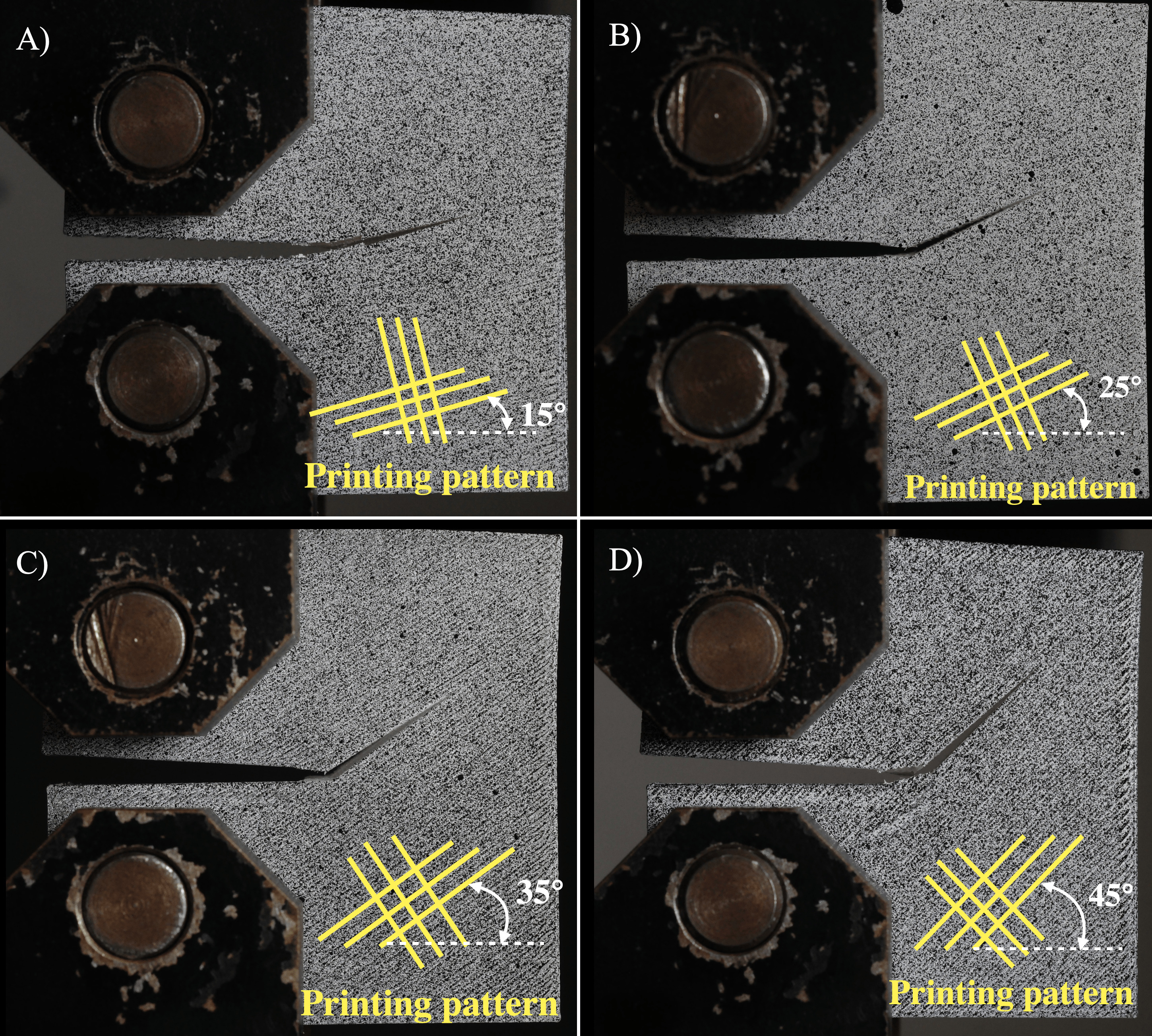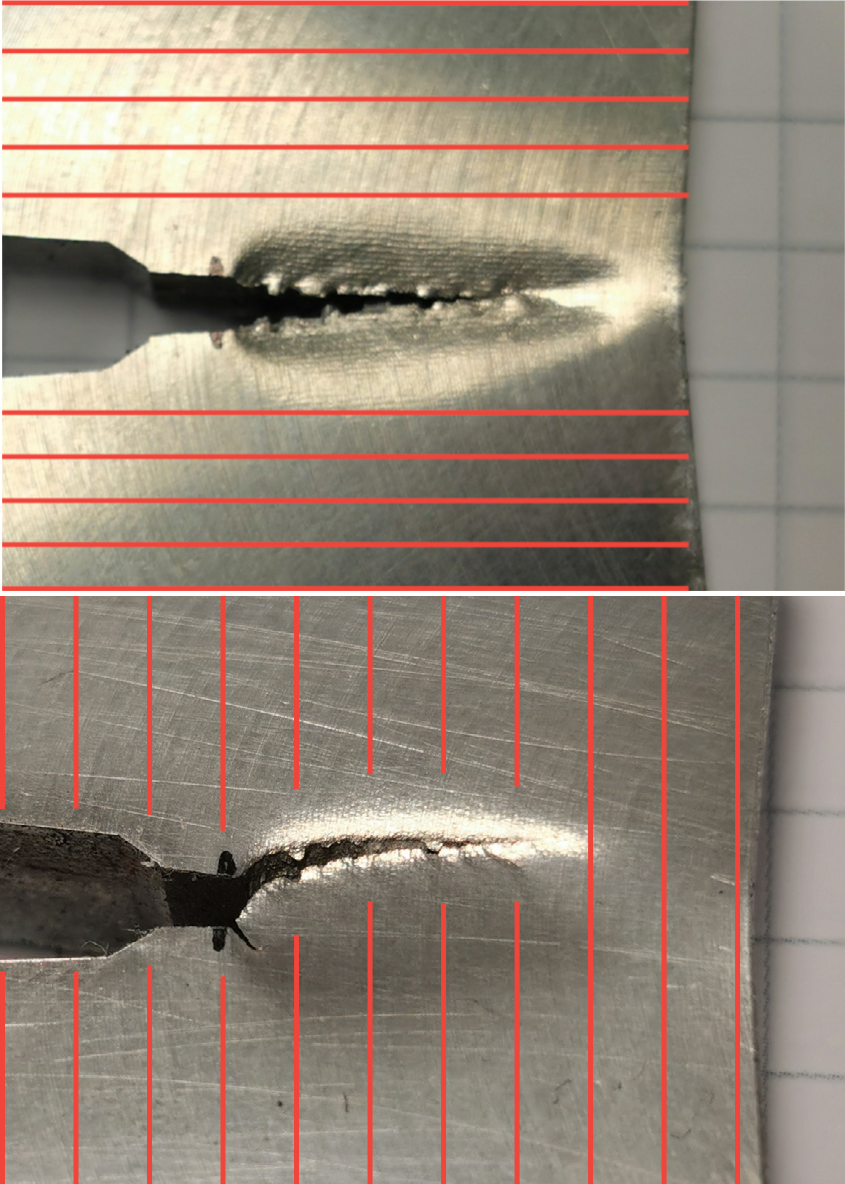Modelling and simulating crack propagation in 3D-printed structures
Phase field fracture: Towards a generic method to follow the equilibrium path of the structure
Congrès des Jeunes Chercheurs en Mécanique
IMSIA, ENSTA Paris, CNRS, EDF, Institut Polytechnique de Paris 91120 Palaiseau, France
August 28, 2024
Fracture in 3D-printed structures


Global objective
Fracture mechanics problem
We consider
- a domain \(\Omega\) with a pre-crack \(\Gamma_0\),
- an elastic material (\(E\), \(\nu\)),
- a force or displacement load,
and we want to determine
- the crack-path,
- the force-displacement curve,
- the evolution of the displacement field.
To solve this problem, we want to employ numerical methods.
Phase-field fracture
The state of a domain \(\Omega\) is described by:
- a displacement field \(\boldsymbol{u}(\boldsymbol{x})\),
- a crack phase field \(\alpha(\boldsymbol{x})\).
The state fields are governed by an energy minization problem, \[ (\boldsymbol{u}, \alpha) = \arg\min_{\substack{\boldsymbol{u}^* \in \mathcal{U} \\ \alpha^* \in \mathcal{A}}} \ \underset{\text{elastic}}{\mathcal{E} (\boldsymbol{u}^*, \alpha^*)} + \underset{\text{dissipation}}{\mathcal{D} (\alpha^*)} - \underset{\text{external work}}{\mathcal{W}_{\mathrm{ext}} (\boldsymbol{u}^*)} \]
Issues due to fracture (displacement loading)
Issue due to fracture (force loading)
Path-following methods 1
Applications to phase-field fracture
Can we introduce path-following in simulations of phase-field fracture?
With some constraints:
- Simplicity (minimize intrusivity, no switch).
- Flexibility (no model dependency, no problem dependency).
- Robustness (no mesh dependency, no divergence).
Control equation
Control by Maximum Strain Increment (Chen & Schreyer, 1990)
The idea is to limit the maximum strain variation in the domain using the equation \[ \max_{\boldsymbol{x}\in \Omega} \left( \frac{\boldsymbol{\varepsilon}(\boldsymbol{u}_{n-1})}{\| \boldsymbol{\varepsilon}(\boldsymbol{u}_{n-1}) \|} : {\color{\red}\Delta \boldsymbol{\varepsilon}(\boldsymbol{u})} \right) - \Delta \tau= 0, \]
where \(\Delta \tau\) is the step size.
Solving the problem (alternate minimization)
Applications
SENT specimen: Presentation
SENT specimen: Displacement control
SENT specimen: Path-following control
CT specimen with force boundary conditions
Conclusion
We applied a path-following method based on control by maximum strain increment.
It proved to be:
- simple: small changes to the elastic solver, none to the crack-phase solver.
- flexible: no problem nor model dependencies.
Yet, we observed some divergence of the resolution in some specific cases.
Thank you for your attention !
F. Loiseau, V. Lazarus
flavien.loiseau@ensta-paris.fr
References
References
Appendices
Systematic literature review
Query
Search on Scopus using the following query in April, 2024.
("load control" OR "path following" OR "path-following" OR "arc length" OR "arc-length" OR "continuation")
AND ("phase-field")
AND ("fracture")Results
- 15 articles
- 2 filtered out
- 1 written in chinese
- 1 unrelated
- 2 added articles (not in the search, found by previous researches)
Notes
- Main contributors at TU Delft
- Few load control methods applied to PF
- Various solving algorithm (staggered/monolithic)
- Small/No comparison to LEFM
- No comparison to expe
Phase-field fracture
The state of a domain \(\Omega\) is described by:
- a displacement field \(\boldsymbol{u}(\boldsymbol{x})\)
- a crack phase field \(\alpha(\boldsymbol{x})\)
The state of the domain verifies \[ (\boldsymbol{u}, \alpha) = \arg\min_{\substack{\boldsymbol{u}^* \in \mathcal{U} \\ \alpha^* \in \mathcal{A}}} \mathcal{E}_{\mathrm{tot}} = \arg\min_{\substack{\boldsymbol{u}^* \in \mathcal{U} \\ \alpha^* \in \mathcal{A}}} \mathcal{E} (\boldsymbol{u}^*, \alpha^*) + \mathcal{D} (\alpha^*) - \mathcal{W}_{\mathrm{ext}} (\boldsymbol{u}^*) \]
where the energy functionals are,
\[ \begin{split} \mathcal{E} (\boldsymbol{u}, \alpha) &= \int_{\Omega} \frac{1}{2} a(\alpha) \boldsymbol{\varepsilon}(\boldsymbol{u}) : \mathbf{E}: \boldsymbol{\varepsilon}(\boldsymbol{u}) \,\mathrm{d}x, \\ \mathcal{D} (\alpha) &= \int_{\Omega} \frac{G_c}{c_w} \left( \frac{w(\alpha)}{\ell} + \ell \nabla \alpha \cdot \nabla \alpha \right) \,\mathrm{d}x, \\ \mathcal{W} (\boldsymbol{u}) &= \int_{\partial \Omega} \lambda \boldsymbol{t}_{\mathrm{ctrl}}\cdot \boldsymbol{u}^* \,\mathrm{d}x. \end{split} \]
Staggered scheme (alternate minimization)
The minimization problem can be solved by splitting the problem into two subproblems:
- minimization with respect to the displacement field \(\boldsymbol{u}(\boldsymbol{x})\) \[ \boldsymbol{u}(\boldsymbol{x}) = \arg\min_{\boldsymbol{u}^* \in \mathcal{U}} \mathcal{E}_{\mathrm{tot}} (\boldsymbol{u}^*, \alpha), \]
- minimization of the functional with respect to the crack phase field \(\alpha(\boldsymbol{x})\) \[ \alpha(\boldsymbol{x}) =\arg\min_{\alpha^* \in \mathcal{A}} \mathcal{E}_{\mathrm{tot}} (\boldsymbol{u}, \alpha^*). \]
We need to introduce the solving of the control equation.
Solving procedure (displacement + load factor)
- Solve the displacement field \(\bar{\boldsymbol{u}}\) associated with a unitary load (\(\lambda = 1\))
\[ \begin{split} \forall \boldsymbol{v}\in \mathcal{U}_0, \quad & \int_{\Omega} a(\alpha) \boldsymbol{\varepsilon}(\bar{\boldsymbol{u}}) : \mathbf{E}: \boldsymbol{\varepsilon}(\boldsymbol{v}) \,\mathrm{d}x + \int_{\partial \Omega} \boldsymbol{t}_{\mathrm{ctrl}}\cdot \boldsymbol{v}\,\mathrm{d}x = 0, \end{split} \]
Solve the control equation for each \(\boldsymbol{x}\in \Omega\) with \[ \frac{\boldsymbol{\varepsilon}(\boldsymbol{u}_{n-1})}{\| \boldsymbol{\varepsilon}(\boldsymbol{u}_{n-1}) \|} : \overbrace{({\color{\red}\lambda(\boldsymbol{x})} \boldsymbol{\varepsilon}(\boldsymbol{u}_{n-1}) - \boldsymbol{\varepsilon}(\boldsymbol{u}_{n-1}))}^{\Delta \boldsymbol{\varepsilon}(\boldsymbol{u})} - \Delta \tau= 0 \iff \lambda(\boldsymbol{x}) = \frac{\Delta \tau- a_0}{a_1}, \] where \(a_0 = \frac{\boldsymbol{\varepsilon}_{n-1} (\boldsymbol{x})}{\| \boldsymbol{\varepsilon}_{n-1}(\boldsymbol{x}) \|} : \boldsymbol{\varepsilon}_{n-1}(\boldsymbol{x})\), and \(a_1 = \frac{\boldsymbol{\varepsilon}_{n-1} (\boldsymbol{x})}{\| \boldsymbol{\varepsilon}_{n-1}(\boldsymbol{x}) \|} : \boldsymbol{\varepsilon}(\bar{\boldsymbol{u}})\).
Select the load factor using the nested interval algorithm (Lorentz & Badel, 2004).
Calculate the displacement field \(\boldsymbol{u}(\boldsymbol{x}) = \lambda \bar{\boldsymbol{u}}(\boldsymbol{x})\).